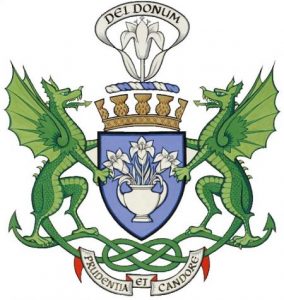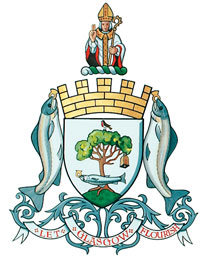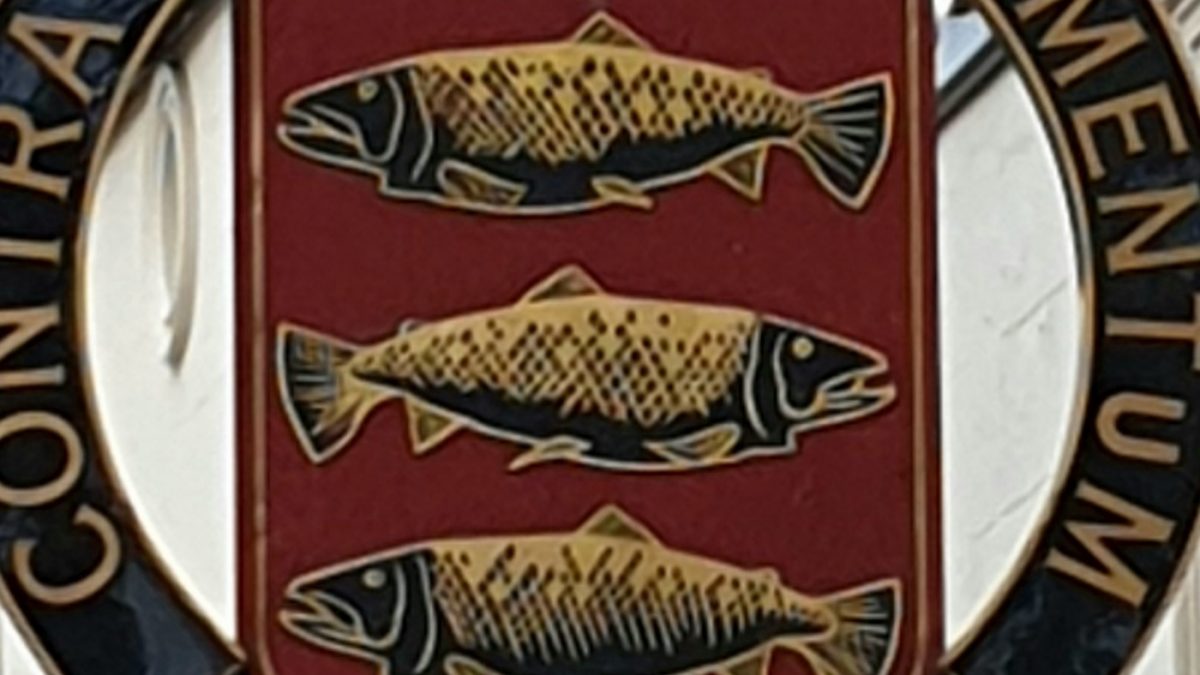
A walk through my hometown this week took me along the High Street and past the County Inn, a local pub and former coaching inn for the stage coaches to Edinburgh. The façade of the building is 18th century but part of the interior is much older, consisting of a “bastle house” which was a type of fortified building with barrel vaulting, small or no windows, and walls up to a metre thick. At one time there were hundreds of these bastle houses across the Borders region, designed to protect people and livestock from robbery and violence during the tumultuous times of the cross border raids. The pub has a rather lovely sign outside which depicts the burgh coat of arms: three salmon on a red background, and the town motto Contra Nando Incrementum which led me to thinking about the topic of today’s blog post!
Civic coats of arms in Scotland are rich and varied, and many have a long history, often dating to medieval times.
Peebles: The arms of the town are incredibly old, and the image of the three fish features on the town cross which is thought to date from the early 14th century. Peebles lies on the River Tweed, which is known as the “Queen of the salmon rivers”. The placement of the fish on the coat of arms refers to the fact that salmon head upstream annually to breed, and implies that for every fish which returns to the river to spawn, two return to the sea. The Latin motto contra nando incrementum translates as “against the tide we multiply” which embodies the idea that by striving, we grow and prosper. Or you could translate it more loosely as “what doesn’t kill me makes me stronger” – either way, I’ve always quite liked it!

The arms of Dundee have been continuously in use for over 600 years and consist of lilies on a blue background which represent the Virgin Mary. The green dragon supporters are thought to represent the patron saint of Dundee, St Clement (who is the patron saint of mariners, very fitting for this city of shipbuilders and seafarers). According to legend, the city got its name when a Scottish prince, David, Earl of Huntington, returned from the Crusades and got caught up in a terrible storm in the Firth of Tay. He made it to safety and gratefully named the place where he landed Donum Dei, meaning “God’s gift” which subsequently evolved into Dundee. It’s a great story, however there is no truth in it! The name is thought to be Gaelic in origin, from dun meaning fort and possibly déagh meaning fire. The second motto “Prudentia et Candore” (with thought and purity) was added in the early twentieth century.

Inverness: perhaps one of the strangest arms in Scotland! No-one really knows why an elephant and a camel appear on the coat of arms of a town in the Scottish Highlands, but they perhaps refer to the city’s medieval trade with the East. Located on the River Ness, with access via the Moray Firth to the North Sea, historically Inverness was an important trading burgh exporting wool, hides and timber. Ship building and fishing were also important industries. The cornucopia crest is symbolic of the town’s wealth and prosperity.

Edinburgh: Edinburgh Castle features twice on the city’s coat of arms, represented by the image of a castle and also by the female supporter. The castle was known historically as the “Castle of the Maidens” – again, no-one really knows why! There are stories and legends which variously refer to Pictish maidens being protected in the castle; a group of nuns who were evicted from the castle in favour of a group of (male) canons; a 5th century religious community consisting of nine women and associated with the castle rock, or perhaps it means a fortification which was never taken by force. You can take your pick!
The other supporter is a doe, emblematic of the city’s patron saint, St Giles. St Giles was a 7th century hermit who spent much of his life living in a forest in the south of France with a deer as his only companion. The story goes that one day, men hunting with the king tried to kill the deer but accidentally shot poor old Giles in the leg instead. By way of compensation, the king built a monastery for Giles (which still exists at St Gilles du Gard near Nîmes) and he spent the rest of his life there, with many miracles being attrbuted to him. So how did he end up being associated with Edinburgh? He became a popular medieval saint, and his cult spread far and wide. Many churches in northern Europe, especially in France and Belgium, are dedicated to him. He is the patron saint of the disabled and also of lepers, and the cathedral of St Giles in Edinburgh’s Old Town is believed to have been built on the site of a leper hospital.
The motto Nisi Dominus Frustra means “Except the Lord in Vain”, a shortened version of a verse from Psalm 127: “Except the Lord build the house, they labour in vain that build it: except the Lord keep the city, the watchman waketh but in vain.”

Glasgow: In the 7th century, St Mungo founded a church in what is now close to the centre of Glasgow, and named its location Glas chu, which is Gaelic for “dear green place”. On the site of Mungo’s church today you will find Glasgow Cathedral, a beautiful building dating from the 12th century and which definitely merits a visit if you find yourself in Scotland’s largest city. Mungo is said to have preached a sermon where he said “Let Glasgow flourish, by the preaching of the word” hence the city’s motto. The symbols on the coat of arms are all associated with the miracles of St Mungo, and Glaswegians of all ages know this wee rhyme:
Here is the bird that never flew
Here is the tree that never grew
Here is the bell that never rang
Here is the fish that never swam
The tree: St Mungo as a young boy was put in charge of a holy fire in St Serf’s Monastery and fell asleep. Some other boys, who were jealous of Mungo, put the fire out. Mungo woke up and broke some branches off a frozen hazel tree, and by praying over them, caused them to burst into flames, restarting the fire.
The bird: St Serf tamed a wild robin and kept it as a pet. The bird died, but Mungo took the dead bird, prayed over it and restored it to life
The fish with a ring in its mouth: a King of Strathclyde gave the ring to his wife as a gift. The Queen gave it to a knight, who lost it. The king grew suspicious of the relationship between the Queen and the knight, and demanded to see the ring, threatening death to the Queen if she could not produce it. The Queen begged St Mungo for help, and he sent a monk to the river Clyde to catch a fish. When the monk returned, the fish was cut open and the ring was found inside.
The bell: the handbell was said to have been given to St Mungo by the Pope and was used in services and to mourn the dead. The original bell has long been lost but a replacement cast in the early 1600s can be seen in the city’s People’s Palace Museum.
Glasgow’s coat of arms can be seen all over the city today, in sculptures, murals and even the decorative lamp posts outside Glasgow Cathedral. Why not see what other coats of arms you can spot on your travels around Scotland?

Related posts
Whoops! No connected account found. Try connecting an account first.


